Seven Questions Over Breakfast with Peter Brown
 April 20th, 2010 by jules
April 20th, 2010 by jules
 So. I’ve been wanting to conduct this interview for a while. Author/illustrator Peter Brown is here to visit. He’s made several really good picture books and is on my illustrator-to-watch list, but here’s where he really outdid himself: Did you see last year’s The Curious Garden, published by Little, Brown in April? It’s what the New York Times called “a quietly marvelous picture book.” Betsy Bird called it “just about the perfect balance of message and text” in her detailed, as always, August 2009 review. It was one of my favorite picture books from last year, though I didn’t cover it at 7-Imp, so consider me making up for that today—plus some—with this interview. (In fact, in 2008, Peter stopped by to show us some early art from The Curious Garden, if fans of that title would like to go back and explore.)
So. I’ve been wanting to conduct this interview for a while. Author/illustrator Peter Brown is here to visit. He’s made several really good picture books and is on my illustrator-to-watch list, but here’s where he really outdid himself: Did you see last year’s The Curious Garden, published by Little, Brown in April? It’s what the New York Times called “a quietly marvelous picture book.” Betsy Bird called it “just about the perfect balance of message and text” in her detailed, as always, August 2009 review. It was one of my favorite picture books from last year, though I didn’t cover it at 7-Imp, so consider me making up for that today—plus some—with this interview. (In fact, in 2008, Peter stopped by to show us some early art from The Curious Garden, if fans of that title would like to go back and explore.)
“Singular style” is a phrase we hear often in the world of illustration, and Peter, undoubtedly, has nailed his with his smooth, stylized, rather retro vibe, playful perspectives, frequent use of earth tones (except for that glorious, blooming garden in The Curious Garden), and tongue-in-cheek visual humor. With Peter’s picture book debut, The Flight of the Dodo, Publishers Weekly called him a promising new talent. Since then, he’s used his droll humor to bring us even more delights, including the precocious, offbeat, and endearing Chowder, the canine star of two of Peter’s titles.

His cover and interior illustrations for Cat Weatherill’s Barkbelly (reviewed here at 7-Imp) and Snowbone (co-reviewed here with Eisha and Betsy Bird), as well as Haven Kimmel’s Kaline Klattermaster’s Treehouse (co-reviewed here with Eisha — man, we loved that book, though it got very little attention, but I digress), also caught my eye. (You know how I feel about illustrated novels, as in YAY!) Peter’s very rounded, sculpted renditions of these characters are ones you feel like you can reach out and pick up off the page. This morning for our breakfast chat, Peter also discusses his current illustrated title, The Purple Kangaroo, the only picture book he hasn’t penned himself, as well as mentions what’s next on his plate.
 And, speaking of plates (bah-dum-ching)… what is he having for breakfast this morning? Get this: “I’m a bit of a French toast connois-
And, speaking of plates (bah-dum-ching)… what is he having for breakfast this morning? Get this: “I’m a bit of a French toast connois-
seur, if I may say so myself. And my favorite recipe calls for soaking thick slices of fresh Cinnamon Raisin Brioche in an orange zest batter, and then cooking it all up in a pan with plenty of butter until the edges are slightly crispy. I sprinkle a little cinnamon or powdered sugar, drizzle it with maple syrup, add a handful of fresh berries and maybe a few pecans or almonds, and I’ll finish the plate with a mint leaf garnish. (Presentation matters!) Then I’ll pour myself a glass of orange juice and a cup of coffee (of course)…and I’ve got my tooth-decaying, artery-clogging breakfast-of-choice. And occasionally my dinner-of-choice.”
I’m speechless. That right there is a work of art.
Let’s get to the interview. First, we’ll set the table and get the basics from Peter before our seven questions over breakfast. I thank him kindly for stopping by.
7-Imp: Are you an illustrator or author/illustrator?
Peter: I’m an illustrator who writes.
7-Imp: Can you list your books-to-date?
Peter: I’ve written and illustrated five picture books: Flight of the Dodo, Chowder, The Fabulous Bouncing Chowder, The Curious Garden, and Children Make Terrible Pets (which comes out this September).
I’ve illustrated one other picture book, The Purple Kangaroo, written by Michael Ian Black.
I’ve illustrated three chapter books: Barkbelly, Snowbone, and Kaline Klattermaster’s Treehouse.
7-Imp: What is your usual medium, or––if you use a variety—your preferred one?
-a.jpg)
Peter: I usually use acrylic-gouache on illustration board.

But I have so much fun with my loose, energetic sketches that lately I’ve been using my drawings as final art…with a bit of digital tweaking. But it’s very important to me that my digital art does not look digital, so I spend a lot of time working with real drawings and real paper and other real materials before I get my computer involved. You’ll see what I mean when Children Make Terrible Pets comes out in September. But here’s a sneak peek:

7-Imp: If you have illustrated for various age ranges (such as, both picture books and early reader books OR, say, picture books and chapter books), can you briefly discuss the differences, if any, in illustrating for one age group to another?
Peter: There are many challenges to making a good picture book. But my favorite of those challenges is finding the right balance between words and pictures. Some stories can be told with no words at all, but most need at least a few words. It’s very rare that a picture book needs a lot of words. If a child wants to read a lot of words, I think they’d sooner pick up an early reader than read a lengthy picture book. And so I strive (with varying degrees of success) to tell interesting, imaginative stories with as few words as possible.
Illustrating a chapter book is quite straightforward. A chapter book’s text is final, and the story has to work well without the help of any illustrations (usually). Sometimes a chapter book may need pictures to clarify a confusing scene, but more often I simply need to find twenty or so scenes that I’d like to illustrate and then have fun making interesting illustrations. It’s a fun job, but not as challenging as illustrating a picture book. Here are a few illustrations I made for Barkbelly, Snowbone, and Kaline Klattermaster’s Treehouse.
-pb.jpg)
-a.jpg)
1.jpg)
7-Imp: Where are your stompin’ grounds?

Peter: I live in Brooklyn! I love it here. Brooklyn is still a little gritty, and it’s beautiful, and it has heaps of culture in a comfortable, livable neighborhood…and obviously Manhattan is a quick subway ride away. I have a great community of friends here, many of whom also make children’s books, so there’s always somebody nearby to commiserate with me on the strange world of children’s book publishing.
7-Imp: Can you briefly tell me about your road to publication?
Peter: At an early age I developed a reputation for being a decent drawer.

In the second grade, I drew a picture of a highway in one-point-perspective, and when my teacher saw it, she put me in my school’s advanced art program, which continued all the way through high school.

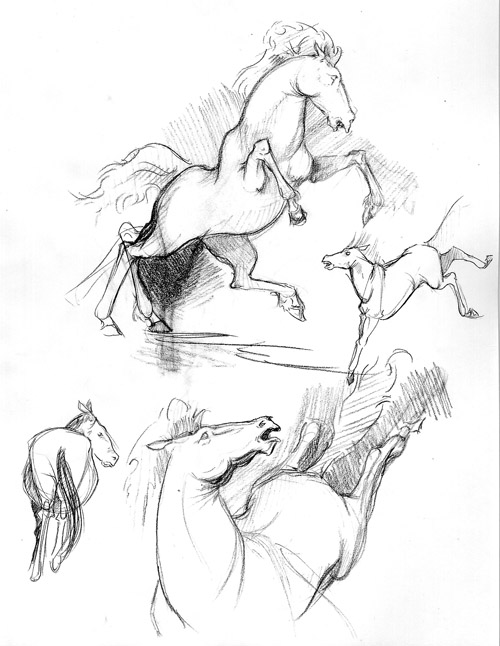

I had an amazing art teacher in high school, Dr. O’Boyle, who really nurtured my talent, and he encouraged me to take many extracurricular art classes. I spent a lot of my time drawing. I especially enjoyed drawing animals from the farms near my house (in the farmy, leafy part of New Jersey) and the animals at the Philadelphia Zoo, where I became a member when I was fourteen.

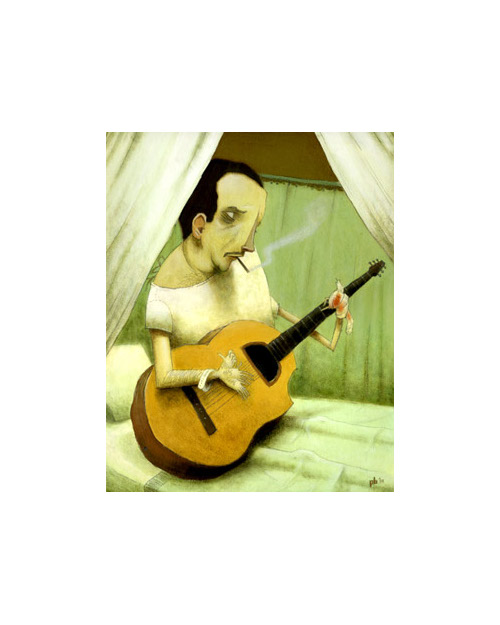
I went on to study Illustration at Art Center College of Design, where I received my BFA. I started off at Art Center thinking I’d eventually work in animation but quickly realized that children’s books offered much greater creative freedom. And so, after my second year there, kids’ books became my focus.

When I moved to New York City in 2002, I was at a party and met a young children’s book editor from Little Brown, named Alvina Ling. I showed her a book dummy I’d made called Flight of the Dodo, and after she helped me polish it up, Little Brown bought it! Flight of the Dodo was published in 2005, and I’ve been working with Alvina ever since.
7-Imp: Can you please point readers to your web site and/or blog?
Peter: www.peterbrownstudio.com
7-Imp: If you do school visits, tell me what they’re like.
Peter: I love visiting schools. These days, I have a cool PowerPoint presentation showing slides of the art I made as a kid, including the first book I ever made at age six, entitled The Adventures of Me and My Dog, Buffy. Kids really love seeing the kind of art and stories I made when I was their age, and since neither my writing nor my drawings were very good, I hope that the kids think to themselves, “Well, if THAT yahoo can write and draw for a living, so can I!”
Also in that slideshow is art I made in art school, samples from my sketchbooks, development art from various book projects, and all the pages of whichever book I happen to be focusing on at that point. It’s great to read a book from a big screen, because ALL of the kids, even the ones in the waaaaay back, can clearly see the illustrations. I always feel silly reading directly from one of my picture books to a large group: The folks in the back certainly can’t see the PICTURES and so they must have no idea what’s going on in the story! What’s the point?!
But I digress…
7-Imp: If you teach illustration, by chance, tell me how that influences your work as an illustrator.
Peter: I don’t teach illustration yet, but I’d love to someday teach a kids’ book illustration class at a college or art school.
7-Imp: Any new titles/projects you might be working on now that you can tell me about?

Peter: My newest picture book is called The Purple Kangaroo, written by Michael Ian Black, the comedian. I never had much interest in illustrating other people’s manuscripts, but Michael wrote a wacky story, and it was a great opportunity for me to experiment with some new illustration techniques, so I happily signed the dotted line. And I think the book turned out great!

Michael and I shot a ridiculous parody video about the making of The Purple Kangaroo, but I’ll warn you, it is not intended for kids. It’s a tad obscene in places, but it’s hilarious. That may seem weird at first, but I think it makes perfect sense: the video is really intended for Michael’s grown-up fans, most of whom share his dark sense of humor and are of child-bearing age. I’ve noticed a definite generational difference in the response to it. My Dad doesn’t like it at all, which is all the proof I need that it’s actually super cool. Whatever the case, it was a lot of fun, and how many chances will I get to shoot silly videos with famous comedians???
As I mentioned earlier, I just completed my next picture book entitled Children Make Terrible Pets, and I am VERY excited about it! It’s about a tutu-wearing bear named Lucy, who finds an adorable little boy in the woods. She calls the boy “Squeaker,” because he doesn’t speak Bear (duh), so whenever he talks all she hears is “Squeak!” (Just like you might name a squeaky pet mouse “Squeaker.”) Anyway, Lucy takes him home to be her pet, and although her mom tries to talk her out of it, Lucy insists and gets her pet boy. Lucy and Squeaker are inseparable! However, slowly but surely, the boy begins acting up and eventually Lucy comes to this realization: “You were right, Mom: Children really do make terrible pets.” This book is a TOTAL giggle-fest. Prepare yourselves.


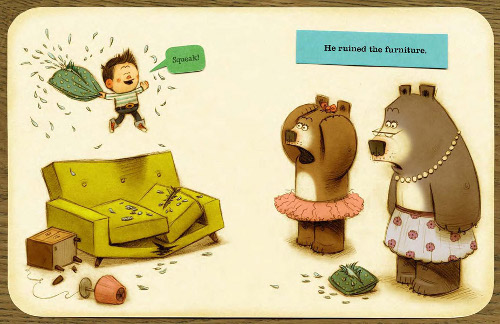
 Our table’s set now for our breakfast interview, and we’re ready to dig in to our French toast. Let’s get a bit more detailed, and I thank Peter again for stopping by.
Our table’s set now for our breakfast interview, and we’re ready to dig in to our French toast. Let’s get a bit more detailed, and I thank Peter again for stopping by.
1. 7-Imp: What exactly is your process when you are illustrating a book? You can start wherever you’d like when answering: getting initial ideas, starting to illustrate, or even what it’s like under deadline, etc. Do you outline a great deal of the book before you illustrate or just let your muse lead you on and see where you end up?


Peter:
INSPIRATION:
My ideas come from all different things: Experiences I’ve had, films (sometimes even TV commercials), books, something I overheard. I never know when ideas will come, so I always keep my notebook with me so I can jot things down and/or make a drawing.
In the case of The Curious Garden, I discovered The High Line in Manhattan. The High Line is an old, elevated railway that became completely overgrown with wildflowers and trees and grasses after closing down in 1980. It made me feel like I was a little kid, and so my initial idea for that book was something like: “a boy discovers a wild garden secretly growing in his dreary city.”


STORY DEVELOPMENT, a.k.a. “SIMMERTIME”:
My ideas never come as fully formed stories, so after I have an interesting idea, I let it simmer in my imagination for days, weeks, months…sometimes years. While my ideas are simmering, I’ll do some “research.” That may be actually studying up on the subject at hand, or it could be examining inspirational books or films or other art forms.
Here’s a gorgeous background painting from Miyazaki’s film Spirited Away, which I used as color inspiration.
.jpg)
In the case of The Curious Garden, I began discovering many places similar to the High Line in every city I visited, in America and Europe, and I would take photos of those places to use as reference later.



As I work through the process of refining my story, I’ll sketch and write and make flow-charts. It’s a very organic process. One quick little doodle might totally change my thinking and lead me to change the story completely.
This is a very anxious time for me, because at this point I’m still not certain that I’ll actually be able to resolve the story, and there’s a little voice in the back of my head saying, “Peeeeeeeeeterrrr…this just might be a stupid story that wouldn’t be worth writing, even if you could; this will prove once-and-for-all that you’re a TERRIBLE author and artist!!!”
I hate that voice.
Anyway, I’ll think, think, think about all the possible versions of my story, I’ll bang my head against the wall (or whatever’s close by), I’ll shed a few tears, and then—by logic and reasoning—I’ll decide why some of my ideas are better, and some are worse, and eventually my story outline will take shape.

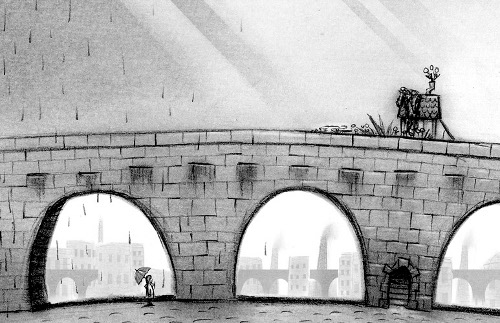


BOOK DUMMY:
When the storyline is resolved, it’s time to decide which parts of the story are best told with words and which are best told with pictures. Using my story outline as a guide, I’ll experiment with lots of different drawings to see which ones work best to tell each part of the visual story. I may have several ideas on how best to depict a certain scene, so I’ll sketch each one and see how they look in comparison to each other.

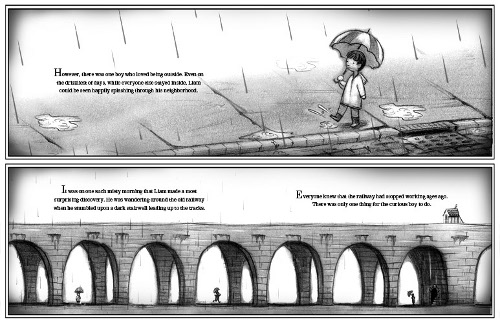
I use Photoshop a lot when making a dummy. It’s very useful for polishing up my sketches and page designs. I’ll scan a few separate drawings and put them all onto one page in Photoshop. I can reposition each element, re-size it, swap one drawing out for another, and look at different versions of the same page, side-by-side. I have so much freedom that eventually I get each page of the book designed exactly as I want it, and I’ll put it all together into my finished book dummy.
As I’m making all of these visual decisions, I’m also going back to my text and deciding if any of my words can be removed. Often, I’ll realize that I’m telling part of the story with both the words AND the pictures, which is redundant, and so I’ll delete a word or a sentence or a paragraph, or I may realize that the pictures just aren’t doing a good enough job of telling the visual story, and I’ll add a new word or sentence to clarify.

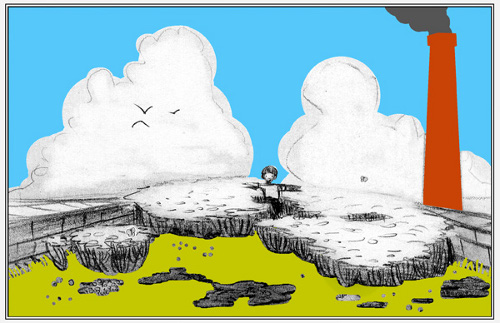
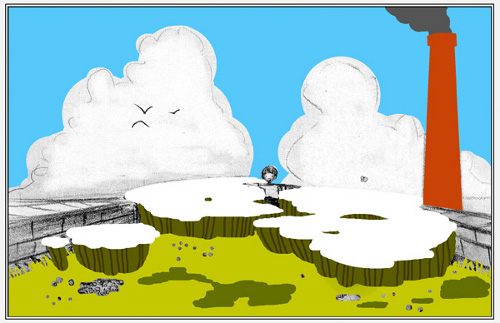


COLOR STUDIES:
After all of the sketches are approved, I’ll make color studies (using Photoshop) to plan the color scheme for the whole book. Photoshop allows me to really fine-tune my color plan and work through tricky color situations before ever beginning to paint. In the images above, you can see how I started with certain colors that I knew I wanted to include (which were inspired by that background painting from Spirited Away), and then I gradually worked through the less important elements, experimenting with a few different colors, until I had a finished study where all the colors worked together harmoniously. I used this first study as a guide for making color studies for the other pages of the book.
FINAL ART:
At this point, all that remains is to make the final art. The hard part is over, because I’ve got sketches and color studies to use as reference for each piece of final art, so there’s really not much thinking left to do. This part is so cool, because after months (and oftentimes years) of fussing with this project, I finally get to see the actual book come to life.
But making the final art is no walk in the park. There are always a few illustrations that I know will kick my butt, so I use what I call “Preventive Psychology” to prevent emotional meltdowns.
TANGENT:
Once upon a time, I had to paint several difficult book illustrations in a row, and they ALL totally kicked my buttocks, sending me into an emotional tailspin and my editor didn’t hear from me for WEEKS, and she finally broke-in to my apartment and found me hiding under a pile of dirty clothes, crying and singing Neil Diamond’s song, “Shilo.” It wasn’t pretty.
FINAL ART (Cont’d):
So, to avoid those kinds of disasters, I take some time to think and plan the order in which I’ll make the final illustrations. I NEVER illustrate a book in the order of its pages, and I NEVER illustrate a book beginning with the easiest illustrations and continuing through to the most difficult. Instead, I’ll flag the illustrations that I know will be tough, and I’ll flag the ones that I know will be the most fun, and I make sure to alternate back-and-forth between them as I make the final art, so that I never have to make two difficult illustrations in a row.
As I paint the illustrations of a book, I often discover little tricks and better ways of illustrating certain elements. For example, after making a few flowery paintings I’ll just naturally get better at painting flowers, so then—after I finish the last illustration of the book—I usually have to go back over each illustration once more to polish up the flowers from the earlier paintings so that all the art looks consistent throughout the entire book.

FINAL POLISHING:
At this point, I should just hand over the final art and be done with the whole project. But to be honest, I usually make tons of last-minute nitpicky changes to the text until my editor finally smacks me and says, “ENOUGH ALREADY! Get a grip! We’re going to press!”

CELEBRATION:
When I’m finally finished with everything, I get paid. Yayyy!!! So I’ll pay off one of my credit cards and then take that credit card and buy tons of drinks for me and my friends.
2. 7-Imp: Describe your studio or usual work space.

Peter: I work from home and, when I’m in the early phases of a project, I spend a lot of time in my living room, surrounded by inspirational kids’ books and art books, as well as my own sketchbooks. This can be a stressful time for me, because at this point I’m still unsure of whether I can turn my idea into a good story, and so I like to be comfortable and relaxed as I plumb the depths of my imagination.

When I’ve got my storyline figured out, I usually relocate to my studio. I have two large desks, side-by-side: one for my computer, the other for painting and other hands-on work. Because I use my computer a lot for research and for composing my final sketches, I actually end up doing a lot of drawing right in front of my computer. I try to keep my studio clean and organized, but at some point, usually when the deadline is looming (or more often, when I’m way past deadline), I give up on keeping the place clean.
3. 7-Imp: As a book lover, it interests me: What books or authors and/or illustrators influenced you as an early reader?
 Peter: My favorite books as a kid are some of my favorite books as an adult. Roald Dahl, Maurice Sendak, Richard Scarry, Robert McCloskey, The Berenstain Bears, The Little Prince, and Golden Books WERE and ARE some of my very favorites. As I got a little older, I plowed through my dad’s collection of Hardy Boys books, and I fell in love with sci-fi/fantasy, like J.R.R. Tolkien and Isaac Asimov. But the truth is that, although I was no dummy, I didn’t read much when I was growing up. In junior high and high school, I thought I wanted to work in animation, so I mostly watched animated films and TV shows, took life-drawing and animation classes, and just drew lots of character-based art.
Peter: My favorite books as a kid are some of my favorite books as an adult. Roald Dahl, Maurice Sendak, Richard Scarry, Robert McCloskey, The Berenstain Bears, The Little Prince, and Golden Books WERE and ARE some of my very favorites. As I got a little older, I plowed through my dad’s collection of Hardy Boys books, and I fell in love with sci-fi/fantasy, like J.R.R. Tolkien and Isaac Asimov. But the truth is that, although I was no dummy, I didn’t read much when I was growing up. In junior high and high school, I thought I wanted to work in animation, so I mostly watched animated films and TV shows, took life-drawing and animation classes, and just drew lots of character-based art.
One of my goals now is to help nerdy-art kids understand that to make your best art you have to be inspired, and there are whole universes of inspiration waiting to be discovered within the pages of books. These days I think of reading as a huge part of my job, and every morning I sit down with my coffee and read for one to two hours. It’s probably my favorite part of the day.
4. 7-Imp: If you could have three (living) illustrators—whom you have not yet met—over for coffee or a glass of rich, red wine, whom would you choose?
1a.jpg) Peter: That’s tough, because I’ve met so many of my contemporaries. But I’d love to have a glass (or four) of rich, red wine with:
Peter: That’s tough, because I’ve met so many of my contemporaries. But I’d love to have a glass (or four) of rich, red wine with:
- Maurice Sendak
- Emily Gravett (pictured right)
- Lisbeth Zwerger
5. 7-Imp: What is currently in rotation on your iPod or loaded in your CD player? Do you listen to music while you create books?
Peter: When I’m drawing or painting, I often listen to NPR for about 12 hours a day (and, YES, I do make contributions!), and when I’ve had enough of that, I’ll listen to mellow stuff like Air, The Bird and the Bee, The Flaming Lips, David Bowie, Curtis Mayfield, Miles Davis, etc.
When I’m writing, I can’t listen to talk radio or any music with English lyrics, because I get distracted. So, then I’ll put on my “writing” playlist, which consists of foreign hip hop, like NTM or Shurik’n; classical music like Bach, Yo Yo Ma, Joshua Bell, and Stokowski; and jazz, like Lester Young, Rodrigo y Gabriela, Oscar Peterson, Astrud/João/Bebel Gilberto, Jimmy Smith, Vince Guaraldi, etc.
6. 7-Imp: What’s one thing that most people don’t know about you?
Peter: When I was very young, I had crazy mecha-godzilla-leg-braces — like Forrest Gump.
7. 7-Imp: Is there something you wish interviewers would ask you — but never do? Feel free to ask and respond here.
Peter: Why Children’s books and not another form of art or writing?
Because being an adult is often kinda stupid. And boring. But with my career, I get to spend most of my time daydreaming, doodling, and giggling. And I get PAID to do it!!! I’m a pretty lucky guy.

7-Imp: What is your favorite word?
Peter: “Finagle.”
7-Imp: What is your least favorite word?
Peter: “Dentist.”
7-Imp: What turns you on creatively, spiritually or emotionally?
Peter: Being deep in nature.
7-Imp: What turns you off?
Peter: Dentistry.
7-Imp: What is your favorite curse word? (optional)
Peter: “Douchebag.”
7-Imp: What sound or noise do you love?
Peter: Lester Young’s saxophone.
7-Imp: What sound or noise do you hate?
Peter: Noisy garbage trucks at 5 a.m.
7-Imp: What profession other than your own would you like to attempt?
Peter: Nature photographer.
7-Imp: What profession would you not like to do?
Peter: Dentistry.
7-Imp: If Heaven exists, what would you like to hear God say when you arrive at the Pearly Gates?
Peter: “What took you so long!?”
Ed. Note: I cannot HELP but post this now:
All artwork, sketches, and images—with the exception of The Little Red Hen cover and the photo of Emily Gravett—used with permission of Peter Brown. All rights reserved. Emily Gravett photo is courtesy of Ms. Gravett; photo credit: Mark Hawdon.
The spiffy and slightly sinister gentleman introducing the Pivot Questionnaire is Alfred, © 2009 Matt Phelan. Thanks to Matt, Alfred now lives permanently at 7-Imp and is always waiting to throw the Pivot Questionnaire at folks.


Oh, Peter Brown is a favorite! This interview is hilarious, and I especially like his tangent and goal of inspiring “nerdy-art kids.”
Also: the combination of bears and stellar typography in Children Make Terrible Pets is making me swoon! One more addition to the Must-Get list.
Thanks for sharing!
Wow, this guy really does live Down Under the (Brooklyn) Bridge.
I love the mix of sketches, finished art, pic book art, chapter book art, and juvenalia (my personal favorite!)!
The video cracked me up, because I’ve never heard of Michael Ian Black before, but I’ve been a big fan of Peter Brown’s art and funny picture books since I bought his first one, Flight of the Dodo.
I can’t wait to see Children Make Terrible Pets. Looks hilarious.
I loved reading about Peter’s process and self-doubt while refining his ideas and creating dummies. I’m in the middle of thinking over all the possible versions of my story for my current WIP dummy, and am glad to know I’m not only one who bangs their head against the wall at that point in the process.
An interview that is both insightful and hilarious – gotta love it. Seems like you had a lot of fun with this one! 🙂
Awesome. As usual, the process sketches are my faves, and I love the urban exploration vibe in the photos — an exotic landscape to my country eyes.
“…when my teacher saw it, she put me in my school’s advanced art program, which continued all the way through high school.”
Anyone else read Gladwell’s Outliers? This is the kind of thing that pops up over and over in that book — a kid shows some promise in some field and is given the opportunity to immerse themselves in it. I love these stories partly because I’m trying to figure out how to provide the best possible opportunities for richness for my kids.
Another great interview! Thanks yet again…
I want that breakfast.
I swear, between you and Jama, I gain weight reading blogs. The calories just seep out of the screen and into my being (or maybe it’s because I go home and immediately start cooking whatever it is I’ve just read about, like those biscuits last week–mmmm).
Wow, I love all those process pieces Peter shared, and I love that he concludes his process with celebration. So important. Also, I applaud his desire to help those nerdy-art kids. I want to be there for them at the library, too.
Thanks for the great interview!I feel like I really got an idea of your creative process.
I like the new sketchy trend. As for myself, I can relate as I am always working on ways to keep that fun free sketchy feel.
Excellent interview. Peter’s process of writing and illustrating is so intertwined that it’s no wonder his books are seamless works of art, each a classic in its own right. They also happen to be beautifully designed, which I now realize is largely because of how much he puts into planning out each page in the dummy stage. It’s incredibly inspiring, and just a wee bit intimidating!
Truly inspiring and funny. I love Peter’s stories. They’re a great balance of message (w/o being preachy), humor and, of course, great art. I think Peter owes me a drink.
I think he owes me a drink, too. (Not really. I just always take free ones when I can get them.)
Ok, ok…Selina, Sean and Jules…I should be finishing my next book in 2 months or so…when that happens I’ll pay off my credit card and then I’ll happily run up some debt on it buying y’all drinks! Ha!
LOVE this interview. So fun to read, and so informative! I LOVE his art, and love watching the process to!
Absolutely loved this! It makes me want to be a children’s book illustrator. I love the point Peter makes about reminding art kids that their inspiration can indeed come from books. Awesome!
We’ve been so enjoying The Curious Garden this week — what a masterpiece. It has that timeless beauty of a classic that will be recognized decades from now…both the art and the words.
What a GREAT interview.
It’s very helpful for me…a newbie in the children’s publishing industry… to see the detail that can go into a book dummy.
I love Peter Brown’s books and can’t wait to see what’s next!
SO informative and wonderful. Thank you!
[…] book. You may remember Peter discussing it (and sharing early spreads and sketches from it) in my April interview with him. Still, though, tomorrow he’s going to stop by and say a bit more about it — […]
[…] you missed last week’s Kirkus column, I discussed the newest picture book titles from Peter Brown, Michael Emberley, and Adam Gudeon. But you know I can’t talk about picture books without […]
[…] at Kirkus, I write about Aaron Reynolds’ Creepy Carrots!, illustrated by Peter Brown, and Michelle Knudsen’s Big Mean Mike, illustrated by Scott […]
[…] about Aaron Reynolds’ Creepy Carrots! (Simon & Schuster, August 2012), illustrated by Peter Brown, and Michelle Knudsen’s Big Mean Mike (Candlewick, August 2012), illustrated by Scott Magoon. […]
[…] I have lots of newer favorites—too many to list—but some great books I’ve read recently include: Journey by Aaron Becker; Ol’ Mama Squirrel by David Ezra Stein; if you want to see a whale by Julie Fogliano and illustrated by Erin Stead; Bink & Gollie: Best Friends Forever by Kate DiCamillo and Alison McGhee and illustrated by Tony Fucile; Once Upon a Northern Night by Jean E. Pendziwol, illustrated by (the amazing) Isabelle Arsenault; and Open This Little Book by Jesse Klausmeier and illustrated by Suzy Lee. And I can’t wait to read Mr. Tiger Goes Wild by Peter Brown. […]
[…] Honor-winning author/illustrator Peter Brown has a new picture book (Little, Brown, September 2013). It’s called Mr. Tiger Goes Wild, and […]
[…] Where was I? … Yes, today I’m chatting with author-illustrator Peter Brown over at Kirkus. And that’s because I think his brand-new picture book, My Teacher is a […]
[…] Center College of Design in Pasadena, California, in ‘98. My good friend and picture book phenom, Peter Brown, and I went to school together, and we were part of a very teeny tiny group of illustrators who […]
[…] Incredible Ink as part of my MFA in Illustration at the Savannah College of Art and Design. I met Peter Brown there when he was visiting to give a lecture, and he sent my work to his agent, Paul Rodeen at […]
[…] week, I wrote here about four new novels, and since three of them are illustrated (Peter Brown’s The Wild Robot, published by Little, Brown in April; Kate Beasley’s Gertie’s Leap to […]
[…] Peter Brown’s working methods are very similar to mine except he plans his spreads in order of difficulty. I don’t account for this ranking system when I’m working in colour but I do make sure everything is worked up to a similar level before going to final art on any spread. […]